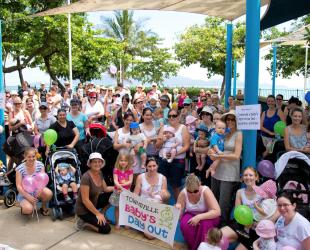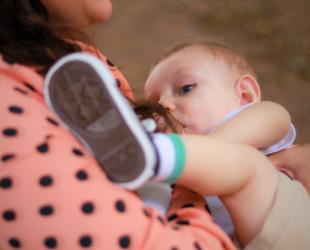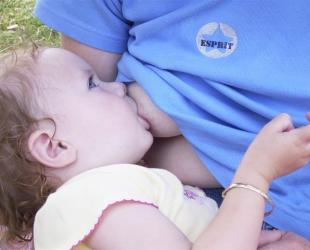What does the law say if your child is still breastfeeding?

The following information is provided to assist separating parents to make informed decisions about infant feeding and care arrangements that are in the best interests of their child.
The Australian Breastfeeding Association does not provide legal advice or assistance in individual legal matters. Only your lawyer can give legal advice that is relevant to you.
When parents separate
The law dealing with parenting arrangements for children of separated and divorced parents is contained in the Family Law Act 1975.
When parents of a child under 18 separate, continued contact with both parents, and with other family members, is considered to be a right of the child. Generally, parents are encouraged to agree between themselves about the future care arrangements of their children.
If you can't reach an agreement, the law requires separating families to make a genuine effort to resolve their issues through a family dispute resolution process before attending court. There are some exceptions to this requirement, such as family violence, child abuse or urgency.
If, as parents, you can't agree, the courts have the power to make parenting orders relating to living arrangements, time spent with each parent and other aspects of parental responsibility. In making such orders, the highest consideration is the best interests of the child.
In determining what is in the best interest of the child, the court must take into account a wide range of factors. These include parental capacity to care for the child, the child’s maturity and cultural background. Breastfeeding is not specifically mentioned in the legislation, but the benefits of maintaining a breastfeeding relationship may be a factor considered by courts in making parenting orders.
Shared parental responsibility
Under the law, there is a presumption that both parents will have an equal parental responsibility — that is, you will both have a role in making decisions about major long-term issues such as where a child goes to school or how to manage major health problems.
- The presumption does not apply if a parent is engaged in abuse of the child or family violence.
- The presumption also does not apply if it is not in the best interests of the child.
Shared parental responsibility is not the same as equal time. Generally, parents will spend equal time with a child only where:
-
They both agree to this arrangement; or
- A court finds that equal time is in the best interests of the child and is the most suitable arrangement.
Parenting arrangements involving breastfed children
The breastfeeding relationship is of critical importance to the health and wellbeing of both the mother and child. The World Health Organization and UNICEF state that:
Breastfeeding is an unequalled way of providing ideal food for the healthy growth and development of infants; it is also an integral part of the reproductive process with important implications for the health of mothers. As a global public health recommendation, infants should be exclusively breastfed for the first six months of life to achieve optimal growth, development and health. Thereafter, to meet their evolving nutritional requirements, infants should receive nutritionally adequate and safe complementary foods while breastfeeding continues for up to two years of age or beyond.
In cases of family separation involving a breastfed child, the parents will need to consider parenting arrangements that accommodate this important relationship. It is entirely possible for separated parents to work out shared care arrangements that allow the partner to have plenty of time with their child while not sacrificing the breastfeeding relationship that child has with their mother.
Information that supports continued breastfeeding
The exact nature of shared care arrangements will vary between families and may change over time. Even so, the following points may assist your family in working out the arrangements that work best for you and your breastfed child.

Breastfeeding for a healthy baby
-
Breastmilk is the normal food for babies, perfectly designed by nature for human infants.
-
There are health risks for babies who are not breastfed, including increased risk of gastrointestinal infections, lower respiratory tract infections, ear infections, sudden infant death syndrome and obesity. 2
-
Breastfeeding must be exclusive to achieve the full benefit of its protective effects. Formula feeding interferes with these protective effects.3
-
Formula is an intervention with potentially negative health outcomes, not a choice on equal (or even almost equal) footing with breastfeeding.
-
Feeding a baby formula has risks, for both the infant and the mother. The evidence for this is both credible and overwhelming. 4-7
Breastfeeding needs time to establish
-
The first 6 to 8 weeks are critical in establishing breastfeeding. During this time, infants need unrestricted access to the breast to establish an adequate milk supply and to develop the learned skill of breastfeeding.
-
Babies learn to breastfeed by breastfeeding — feeding them expressed milk (especially via a bottle) in the early weeks can cause significant difficulties in establishing and maintaining a successful breastfeeding relationship.
-
Even after the first 6 weeks, the frequent use of bottles may lead to nipple confusion and/or breast refusal for some infants.
-
Expressing breastmilk is not instinctive and is a skill that needs to be learned by the mother.
Recommendations on length of breastfeeding and age of weaning
-
The current recommendation is for infants to be exclusively breastfed until 6 months of age. This means an exclusively breastfed infant is entirely reliant on the mother for nutritional needs during this period.
-
Breastmilk continues to be the most important dietary element in the baby’s diet until 12 months of age.
-
After 12 months, breastfeeding continues to be an important part of a child’s experience, supporting their nutritional and emotional health.
-
The World Health Organization recommends that breastfeeding continue for up to 2 years of age or beyond.
-
There is no specific recommended age for weaning as this is a personal decision for each mother and child.
-
There is no evidence that breastfeeding a child beyond infancy is harmful. Quite the opposite is true: breastfeeding benefits toddlers and young children, both nutritionally and psychologically.8,9
More information
The following links contain more information on Australia’s family law system:
- World Health Organization and UNICEF 2003, Global Strategy for Infant and Young Child Feeding, page 8.
- Brodribb W (ed), 2012, Breastfeeding Management in Australia 4th edn. Australian Breastfeeding Association, Melbourne.
- Ibid.
- McNiel ME, Labbok MH, Abrahams SW 2010, What are the risks associated with formula feeding? A re-analysis and review. Birth 37(1):50–58.
- Stuebe A 2009, The risks of not breastfeeding for mothers and infants. Rev Obstet Gynecol 2(4): 222–231.
- World Health Organization 2004, Enterobacter sakazakii and other microorganisms in powdered infant formula: Meeting report. Microbiological Risk Assessment Series 6:11–12.
- Smith JP, Harvey PJ 2010, Chronic disease and infant nutrition: is it significant to public health? Public Health Nutr 14(2):279–289.
- Montgomery SM, Ehlin A, Sacker A 2006, Breast feeding and resilience against psychosocial stress. Arch Dis Child 91:990–994.
- Oddy WH, Kendall GE, Li J, Jacoby P, Robinson M, de Klerk NH, Silbuen SR, Zubrick SR, Landau LI, Stanley FJ 2010, The long-term effects of breastfeeding on child and adolescent mental health: a pregnancy cohort study followed for 14 years. J Pediatr 156:568–574.
© Australian Breastfeeding Association May 2022
This information is as accurate as possible but is not intended to be relied on as legal advice.



